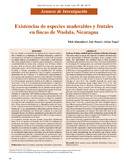Existencias de especies maderables y frutales en fincas de Waslala, Nicaragua
ISSN
1022-7482Fecha de publicación
2013Tipo
Artículo
Metadatos
Mostrar el registro completo del ítemTítulo alternativo
Existence of timber and fruit species on farms of Waslala, Nicaragua
Resumen
En este estudio se evaluaron las existencias de especies maderables y frutales en el municipio de Waslala, Nicaragua, a partir de una muestra de 40 fincas. La información se obtuvo de inventario en campo, talleres con productores y entrevistas a varios actores clave para indagar sobre el manejo, aprovechamiento y canales de comercialización de frutas, leña y madera. Las 40 fincas cubrían un área total de 691 ha: 80% (544,45 ha) bajo usos agrícolas, incluyendo cacao y 20% (146,65 ha) por usos no agrícolas como tacotales y bosque secundario. Se contabilizaron 125 árboles maderables en un área agrícola de 4 ha. La riqueza y densidad de maderables fue de 6 especies y 31 árboles ha-1, respectivamente. Las especies más abundantes fueron: Cordia alliodora (18 árboles ha-1), Cordia bicolor (3 árboles ha-1) y Terminalia oblonga (3 árboles ha-1). La demanda mensual de madera de los talleres y carpinterías varió entre 7,5-11 m3. Las especies preferidas fueron C. alliodora, Laetia procera, Platymiscium pleiostachyum, Persea coerulea. Para leña, las especies más demandadas fueron Hirtella trianda, Inga sp. y Psidium guajava. El precio por la raja de leña depende de la especie y del tamaño de la pieza (entre U$0,10-0,23 raja-1). Además, se registraron 3645 árboles frutales pertenecientes a 14 familias en nueve usos de suelo, aunque los principales fueron los cacaotales, potreros y huertos caseros. La riqueza y densidad de frutales fue de 25 especies y 5 árboles ha-1, respectivamente. Las especies más abundantes fueron Bactris gasipaes (80 árboles ha-1), Citrus sinensis (66 árboles ha-1), Mangifera indica (41 árboles ha-1), Persea americana (36 árboles ha-1) y Citrus reticulata (20 árboles ha-1). Las oportunidades comerciales para las frutas en el municipio son limitadas. Las frutas más vendidas en el mercado municipal fueron los cítricos, abundantes en las fincas. El precio medio pagado al productor osciló entre US$0,5-1,19 por centenar, dependiendo del tamaño de la fruta. La normativa forestal del país permite aprovechar anualmente hasta 10 m3 de madera proveniente de los SAF, sin embargo, los productores no siempre cortan y asierran este volumen de los campos agrícolas de sus fincas. Las autoridades ambientales locales no disponen de un sistema de registro, control y seguimiento del aprovechamiento y comercio de madera y leña consistente y efectivo. Se recomienda buscar nuevos mercados para las frutas, fortalecer los conocimientos silvícolas y dasométricos de productores, equipos técnicos, alcalditos y estudiantes y actualizar y modernizar el sistema de registro y control de la regencia forestal municipal en función del aprovechamiento sostenible de la madera. Existence of timber and fruit species on farms of Waslala, Nicaragua This study aimed to assess the existence of timber and fruit trees in the municipality of Waslala, Nicaragua, from a sample of 40 farms. The information was obtained from a field inventory, workshops with producers and interviews of various stakeholders to investigate the management, use and trade channels for fruit, firewood and timber. The 40 farms cover a total area of 691 ha: 80% (544.45 ha) under agricultural use, including cacao and 20% (146.65 ha) in non-agricultural use such as scrub and secondary forest. We counted 125 timber trees in an agricultural area of 4 ha. The richness and density of timber trees was 6 species and 31 trees ha-1, respectively. The most abundant species were: Cordia alliodora (18 trees ha-1), Cordia bicolor (3 trees ha-1) and Terminalia oblonga (3 trees ha-1). The monthly demand for wood from workshops and carpentry shops ranged from 7.5 to 11 m3. The preferred species were C. alliodora, Laetia procera, Platymiscium pleiostachyum, Persea coerulea. For firewood, the most popular species were Hirtella trianda, Inga sp. and Psidium guajava. The price per cord of firewood depends on the species and the size of the piece (between US$0.10-0.23 cord-1 In addition, we recorded 3645 fruit trees belonging to 14 families in nine land uses, but the main ones were cacao orchards, pastures and home gardens. The richness and density of fruit trees were 25 species and 5 trees ha-1, respectively. The most abundant species were Bactris gasipaes (80 trees ha-1), Citrus sinensis (66 trees ha-1), Mangifera indica (41 trees ha-1), Persea americana (36 trees ha-1) and Citrus reticulata (20 trees ha-1). Commercial opportunities for fruits in the municipality are limited. The fruits sold most in the municipal market were citrus, which is abundant on the farms. The average price paid to producers ranged from US$0.50 to 1.19 per hundred, depending on the size of the fruit. The country’s forestry regulations allow an annual take of up to 10 m3 of timber from AFS, however, producers do not always cut and mill this volume from the agricultural fields on their farms. Local environmental authorities do not have a consistent and effective system for the registration, control and monitoring of the use and trade of timber and firewood. We recommend seeking new markets for fruits, strengthening the silviculture and forestry metric knowledge of producers, technical teams, authorities and students, and updating and modernizing the registration and control system of the municipal forest regency for sustainable timber use.
Palabras clave
Editor
CATIE, Turrialba (Costa Rica)
Es parte de
Agroforestería en las Américas, número 49 (2013)
Programa Agroambiental Mesoamericano (MAP). Fase I



